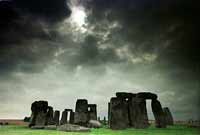Stonehenge served as burial ground at its beginning
New dating of cremated remains shows burials occurred as early as 3000 B.C. when the first ditches around the monument were being built, researchers said Thursday.

Those burials continued for at least 500 years, when the giant stones that mark the mysterious circle were being erected, they said.
"It's now clear that burials were a major component of Stonehenge in all its main stages," said Mike Parker Pearson, archaeology professor at the University of Sheffield in England and head of the Stonehenge Riverside Archaeological Project.
In the past many archaeologists had thought that burials at Stonehenge continued for only about a century, the researchers said.
"Stonehenge was a place of burial from its beginning to its zenith in the mid-third millennium B.C. The cremation burial dating to Stonehenge's sarsen stones phase is likely just one of many from this later period of the monument's use and demonstrates that it was still very much a domain of the dead," Parker Pearson said in a statement.
The research was supported by the National Geographic Society, which discusses Stonehenge in its June magazine and will feature the new burial data Sunday on National Geographic Channel.
The researchers said the earliest cremation burial was a small group of bones and teeth found in pits called the Aubrey Holes and dated to 3030-2880 B.C., about the time with the first ditch-and-bank monument was being built.
Remains from the surrounding ditch included an adult dated to 2930-2870 B.C., and the most recent cremation, Parker Pearson said, comes from the ditch's northern side and was of a 25-year-old woman. It dated to 2570-2340 B.C., around the time the first arrangements of large sarsen stones appeared at Stonehenge.
According to Parker Pearson's team, this is the first time any of the cremation burials from Stonehenge have been radiocarbon dated. The burials dated by the group were excavated in the 1950s and have been kept at the nearby Salisbury Museum.
In the 1920s an additional 49 cremation burials were dug up at Stonehenge, but all were reburied because they were thought to be of no scientific value, the researchers said.
They estimate that up to 240 people were buried within Stonehenge, all as cremation deposits.
Team member Andrew Chamberlain suggested that that the cremation burials represent the natural deaths of a single elite family and its descendants, perhaps a ruling dynasty.
A clue to this, he said, is the small number of burials in Stonehenge's earliest phase, a number that grows larger in subsequent centuries, as offspring would have multiplied.
Also, Parker Pearson added: "I don't think it was the common people getting buried at Stonehenge; it was clearly a special place at that time. One has to assume anyone buried there had some good credentials."
The actual building and purpose of Stonehenge remain a mystery that has long drawn speculation from many sources.
Subscribe to Pravda.Ru Telegram channel, Facebook, RSS!



